This is the DM’s map for running the Avernian hexcrawl. It’s designed for use with the Alexandrian Hexcrawl, as described in the 5E Hexcrawl series. We’ll be making some tweaks to this structure, however, to accommodate the unusual features of Avernus.
HEX SCALE
1 Hex = 40 miles (center to center / side to side) = 23 mile sides = 1385 square miles
The Avernian Hexcrawl uses 40 mile hexes. When tracking progress, this means it requires 20 miles of progress to exit a hex through one of the two nearest faces. (If they exit back through the face through which they entered the hex for a reason other than doubling back along their own trail, it requires 2d10 miles of progress to exit the hex, unless circumstances suggest some other figure.)
Design Note: The primary reason for choosing a 40 mile scale is because the PCs are likely to end up using infernal machines with much higher speeds of travel. The secondary reason is aesthetic: Avernus is supposed to be a wasteland. By increasing the scale of the hexes, we achieve that (increasing the average distance between points of interest).
OPPRESSIVE ENVIRONMENT
The conditions in Avernus are debilitating, alien, and severe, particularly for mortals. In addition to the normal encounter check, there is a 1 in 6 chance per watch that an oppressive condition will begin. Once begun, an oppressive condition continues until another 1 in 6 check per watch ends the effect.
| d12 | Oppressive Condition |
|---|---|
| 1-3 | Extreme Heat |
| 4-6 | Choking Miasma |
| 7-9 | Psychic Evil |
| 10 | Acid Rain |
| 11 | Rain of Stones |
| 12 | Terrain Condition |
EXTREME HEAT: Temperatures reach extreme heat. A creature exposed to extreme heat must succeed on a Constitution saving throw at the end of each hour or gain one level of exhaustion. The DC is 5 for the first hour and increases by 1 for each additional hour. Creatures wearing medium or heavy armor, or clad in heavy clothing, have disadvantage on the saving throw. Creatures with resistance or immunity to fire damage automatically succeed on the saving throw, as do creatures native to Avernus. A successful saving throw while resting resets the DC to 5.
CHOKING MIASMA: Thick, noxious fumes fill the air. They may have a source (like volcanic clouds rolling off the mountains) or they may seem to rise from the ground or even just spontaneously emerge from the air itself. At the end of each watch, creatures must succeed on a DC 15 Constitution saving throw or suffer one level of exhaustion. Creatures who are resting gain advantage on the saving throw. Creatures with resistance or immunity to poison automatically succeed on the saving throw, as do creatures native to Avernus.
PSYCHIC EVIL: The supernatural evil of the Nine Hells weighs on the bodies and souls of those who are not evil. A non-evil creature must make a DC 15 Constitution saving throw at the end of each watch or suffer 1d3 points of psychic damage.
ACID RAIN: Thick purple clouds spatter the plains with burning acid. A creature without shelter suffers 1d6 acid damage per hour.
RAIN OF STONE: Small meteors pelt the plane. Creatures without shelter must succeed on a DC 12 Constitution saving throw each watch or suffer 1d6 bludgeoning damage per hour. There is a 1 in 10 chance per watch that the meteor storm intensifies, with blazing orbs of fire plummeting from the sky. Creatures without shelter must succeed on a DC 15 saving throw or suffer 5d6 fire damage and 5d6 bludgeoning damage.
TERRAIN CONDITION: Each type of Avernian terrain has an oppressive condition. This result on the table indicates that you should use the oppressive condition of the terrain in the expedition’s current hex.
As noted below, some terrain conditions do not persist. They occur once in the watch during which they are rolled, and then additional checks for oppressive conditions immediately resume in the next watch.
AVERNIAN TERRAIN
The wasteland of Avernus is scattered with rocks of obsidian and quartz. There’re mountains dotting the bloody-dusty plain, and foothills march across the land like the overturned tracks of some gargantuan, unknown beast. – Planes of Law (1995)
ASHLANDS: The ground here is covered in a thick layer of black ash, generally varying in depth form six to eighteen inches. The ash does not easily compress or support weight, so travelers will 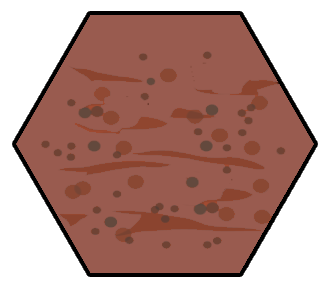 often find themselves more or less wading through the ash.
often find themselves more or less wading through the ash.
Oppressive Condition – Ash Pit: In some areas the thin layer of ash is much deeper than it appears. Sentinels can attempt a DC 18 Wisdom (Perception) check to spot the ash pit as the expedition approaches. If no one spots the ash pit, 1d4 random characters in the expedition must make a DC 15 Dexterity saving throw or abruptly sink 2d4 feet deep in the ash.
At the start of each ash-bound creature’s turn, they sink another 1d4 feet into the ash. A character can attempt to escape by using their action to make a Strength check with a DC equal to 10 plus the number of feet they’ve sunk into the ash. If they have become completely submerged, they suffer disadvantage on this check and also begin suffocating.
Ash pits do not persist as an oppressive condition.
BONE BRAMBLES: A maze of warped trees and bonelike vines. Calcified corpses merge with the trees, covered in fungal pods that feed on the blood oozing through the undergrowth. 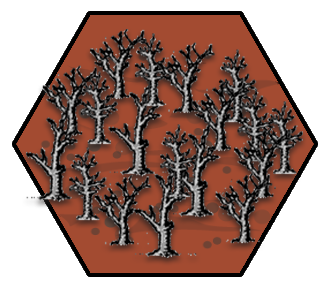 Experienced Avernian explorers know that bone brambles often grow up around sources of fresh water.
Experienced Avernian explorers know that bone brambles often grow up around sources of fresh water.
Oppressive Condition – White Mists: The brambles exude a thick, cloying, almost oily white mist. This creates a condition of poor visibility (halving moving speeds and giving disadvantage on navigation and forage checks). The mist is almost refreshingly cool by Avernian standards, but there are strange whispers and disturbing groans that come and go among the mists.
CAUSTIC BOGS: On the current map, the caustic bogs are formed from the polluted run-off from Bel’s Forge (Hex H2), but similar areas can be found across Avernus, 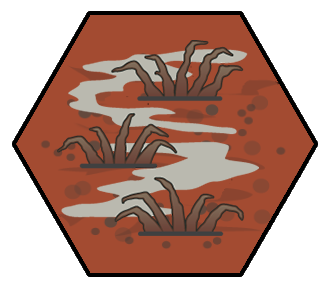 horrific remnants of the Blood War.
horrific remnants of the Blood War.
While travelling through the caustic bogs, characters must succeed on a DC 12 Constitution saving throw each watch or gain the Poisoned condition. The character can repeat the saving throw every 24 hours, ending the effect on itself on a success.
Oppressive Condition – Caustic Pollution: Characters must succeed on a DC 15 Constitution saving throw or suffer 1d3 acid damage.
HILLS, AVERNIAN: Either low mounds that undulate out of the wastelands or jagged 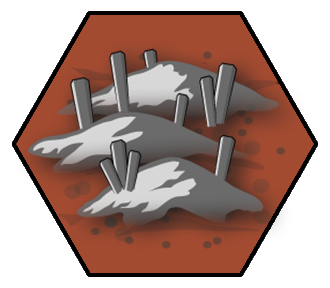 promontories of razor-like rock that jut toward the blood red sky. The native life of Avernus, such as it is, often clings and clusters in the hills.
promontories of razor-like rock that jut toward the blood red sky. The native life of Avernus, such as it is, often clings and clusters in the hills.
Oppressive Condition – Scree: See the Wastelands terrain below.
MOUNTAINS, AVERNIAN: There are generally two types of mountains in Avernus. Newer mountains that thrust up like broken blades of obsidian; raw and dangerous. And the older mountains that have been worn down by countless aeons, their gray immensity aching with an age incalculable to the mortal soul.
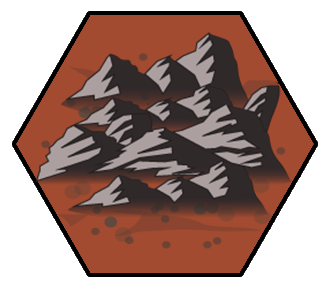 Oppressive Condition – Tremor: Avernus in general is tectonically unstable and this effect is magnified along the mountain crests. This condition indicates a tremor significant enough to disrupt travel, imposing a x ¾ speed modifier for the current watch. 1 in 10 such tremors are more serious, triggering significant hazards like an avalanche, rockslide, cave collapse, or the like.
Oppressive Condition – Tremor: Avernus in general is tectonically unstable and this effect is magnified along the mountain crests. This condition indicates a tremor significant enough to disrupt travel, imposing a x ¾ speed modifier for the current watch. 1 in 10 such tremors are more serious, triggering significant hazards like an avalanche, rockslide, cave collapse, or the like.
This does not persist as an oppressive condition.
PLAINS OF FIRE: An iridescent, tarry putrescence seeps up through the soil here. These alchemical slicks catch on fire, a combination of small ever-burning wells and 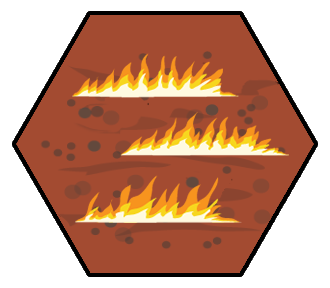 huge infernos miles long and high.
huge infernos miles long and high.
Failing a navigation check in the plains of fire, at the DM’s discretion, may indicate that the group has gotten cut off by a rapidly spreading fire, trapping the PCs in the eye of a firestorm.
It is never considered a clear day in the Plains of Fire.
Oppressive Condition – Extreme Heat: As described above.
PIT OF SHUMMRATH: A grand canyon more than a mile deep and filled with a lake of green slime that undulates as though breathing. The slime is actually the protoplasmic residue of an ancient devil imprisoned here by Archduke Bel many centuries ago, still possessed of some residual sentience and a telepathic ability to communicate (see p. 100 of Descent Into Avernus).
Large sections of the Shummrathian slime actually have a very thick skin, allowing the brave and foolhardy to walk across its slightly undulating surface. In slightly less gelatinous sections of the Pit, barges can dredge their way across.
Oppressive Condition – Telepathic Agony: An overwhelming telepathic burst emanates from the canyon, communicating in a single searing thought the eternal agony of Shummrath’s shattered consciousness. Characters must succeed on a DC 15 Wisdom saving throw or suffer 2d6 psychic damage.

WASTELANDS: The wastelands of Avernus look like sand, but are mostly made up of 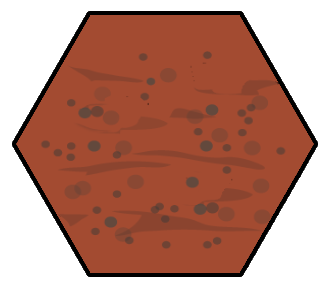 hard, sharp rocks akin to the quartzes and obsidian of the Material Plane. Footing can be treacherous.
hard, sharp rocks akin to the quartzes and obsidian of the Material Plane. Footing can be treacherous.
Oppressive Condition – Scree: Traveling characters must make a DC 12 Dexterity saving throw each watch or suffer 1d3 damage. A character failing the saving throw must immediately attempt another, repeating until they succeed on a check or choose to stop traveling (in which case their distance traveled for the watch is halved).
WASTELANDS, CRACKED: The surface of Avernus is a rotten rind stretched across a 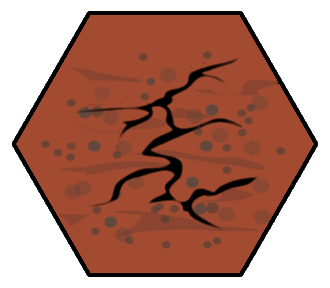 festering fruit. In places, the ground has split apart. In cracked regions of the wastelands, the land is riven with fissures and ravines. Navigating these regions is difficult, either requiring great effort to circle around impassable chasms, or maze-like passages through the fissures themselves.
festering fruit. In places, the ground has split apart. In cracked regions of the wastelands, the land is riven with fissures and ravines. Navigating these regions is difficult, either requiring great effort to circle around impassable chasms, or maze-like passages through the fissures themselves.
Oppressive Condition – Scree: See the Wastelands terrain above.
VOLCANIC PLAINS: Vast, smooth plains of black, basaltic rock. Sometimes shattered by tectonic upheavals. Often studded with fissure vents and bubbling pools of fresh lava.
An unusual feature of Avernian volcanic plains are the kipukas: Isolated areas of older lava flows surrounded by newer flows. On Avernus, these kipukas are often etched with the 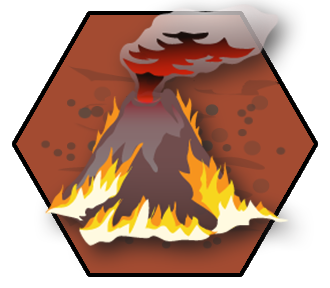 characters of some ancient and utterly forgotten tongue.
characters of some ancient and utterly forgotten tongue.
Oppressive Condition – Volcanic Event: Journeying near an active volcano is, of course, not safe in any circumstances, and even less so given the churning activity of a typical Avernian caldera. There are several volcanic events that could arise as an oppressive condition.
- A choking miasma of volcanic gas (see Oppressive Environment, above). More serious outbreaks of volcanic gas are also possible; resolve as a cloudkill
- An active lava flow, blocking the desired path of travel.
- A tephra fall, in which multiple inches and even several feet of ash can fall as precipitation. Add +2 to the DC of navigation checks and +4 to the DC of forage checks.
- A lahar, a violent mudflow formed from a slurry of pyroclastic material. (Resolve like an avalanche.)
- An eruption. This might be modeled by requiring the PCs to flee the hex within a certain timeframe.
| Terrain | Highway | Road/Trail | Trackless | Navigation DC | Forage DC |
|---|---|---|---|---|---|
| Ashlands | x1 | x1 | x ½ | 12 | 24 |
| Bone Brambles | x1 | x1 | x ½ | 18 | 16 |
| Caustic Bogs | x1 | x ¾ | x ½ | 15 | 20 |
| Hills, Avernian | x1 | x ¾ | x ½ | 14 | 18 |
| Mountains, Avernian | x ¾ | x ¾ | x ½ | 16 | 22 |
| Plains of Fire | x1 | x ¾ | x ½ | 14 | 24 |
| Pit of Shummrath | x1 | x ¾ | x ¼ | 15 | 22 |
| Wastelands | x1 | x1 | x ¾ | 12 | 20 |
| Wastelands, Cracked | x1 | x ¾ | x ½ | 16 | 20 |
| Volcanic Plains | x1 | x ¾ | x ¾ | 12 | 24 |
Note: Although values are given for Highway speed, there are no such causeways in this section of Avernus. (They’re quite rare in Avernus in general.)
THE STYX
The effects of the River Styx are described on p. 76 of Descent Into Avernus.
It should be noted that these effects apply only to the waters of the river itself. The Styx is fed by a number of tributaries which do not share these effects until they join the main channel of the Styx. In Avernus, these tributaries may be water, but are more likely to be fouler effluvia. (In places within Avernus there are whole systems of rivers and lakes filled with nothing but the blood and bile and other fluids of mortal creatures spilling down into the Styx.)
NAVIGATING AVERNUS
Avernus… Its blasted, rock-strewn fields gape like festering wounds under a crimson sky. Neither stars nor sun brighten the infinite reach of this layer’s sky, for the blood-red light emanates from the air itself. There’s no way to keep time in Avernus, save by the screaming of the [suffering]. – Planes of Law (1995)
COMPASS DIRECTIONS: Cardinal and ordinal directions don’t exist in Avernus. (There is no rising sun, no stars in a night sky, and no magnetic field for aligning compasses.) This imposes disadvantage to navigation checks until a navigator has adapted to the oddities of Avernian geography (by successfully reaching an intended destination for the first time).
PLANAR COMPASS: A planar compass is a technomantic device which allows for navigation in the Outer Planes. A planar compass aligns to the nearest planar borders. In this particular region of Avernus that corresponds to the planar borders with Dis (to the “north” side of our map) and the Abyss (to the “east”). Thus Dis-ward, Abyss-ward, contra-Dis, and contra-Abyss.
Design Note: For simplicity, you might still want to use the familiar cardinal directions at the table. Here’s one way you could justify that: The word “north” actually derives from a word meaning “left” because it was the direction to the left of the rising sun. You could hypothesize an Avernian dialect in which the direction towards the Abyss (and the front lines of the Blood War) is adversa, and “Avernian north” is the direction to the left of that. In translation to the Common tongue, the common names – north, east, south, west – are extrapolated accordingly.
SIGHTING MOUNTAINS: In the absence of stars, sun, or magnetic fields, navigation in Avernus relies heavily on landmarks. In this particular region of Avernus, this is greatly aided by the Dispatrian Mountains that lie Dis-ward and the Praefervian Mountains to the contra-Dis.
On a clear day, both mountain ranges can be seen at a distance of two hexes (80 miles), but will frequently only be visible from 1 hex away. The thick haze of the Avernian atmosphere, however, usually reduces this to a single hex. Volcanic peaks indicated on the map (like Bel’s Forge in Hex H2) can similarly be seen at a distance of 1-2 hexes.
IDENTIFYING MAP LOCATIONS: If the PCs make inquiries, assume that Avernian natives can identify 1d6-1 locations on the player’s map.
OTHER AVERNIAN GUIDELINES
FORAGING: Food and water – particularly that suitable for mortal consumption – is hard to come by in Avernus. The native flora and fauna have a bitter or ashen flavor, and even drinkable water usually tastes foul.
Mortals make forage checks in Avernus at disadvantage. (Hell is not a place for mortals.) This does not apply to characters with demonic or devilish heritage (such as tieflings), who will find a broader range of Avernian wildlife suitable for their palates.
SPOTTING DISTANCE: Avernus is flat, which means there’s no horizon to block vision. With a clear line of sight you could hypothetically see an infinite distance… if it wasn’t for the atmosphere. On a perfectly clear day on Earth you can see about 150 miles through the atmosphere, but such conditions are rare on Earth and virtually impossible in Avernus.
Assume a 1 in 6 chance of a clear day.
On a typical day:
- A character taking the Sighting watch action can see their current hex.
- Mountains can be seen 1 hex away.
On a clear day (by Avernian standards):
- A character taking the Sighting watch action can see 1 hex (40 miles) away.
- Mountains can be seen 2 hexes away.
- Encounter spot distances in plains- or desert-type terrain (ashlands, wastelands, volcanic plains) are doubled. (Emphasize the disorienting nature of seeing creatures at such great distances to those unaccustomed to planar travel.)
UNSUITABLE TERRAIN: Land vehicles perform poorly in unsuitable terrain. Infernal war machines are well-suited to the Avernian wastelands, however, and are likely to only find mountainous terrain unsuitable. At the DM’s discretion they might also find unusual terrain like the Pit of Shummrath or the caustic bogs similarly problematic.
Some map icons from Hells Upper Levels by Keith Curtis via Inkwell Ideas.
Additional icons by Kevin Chenevert of RedKobold.com.

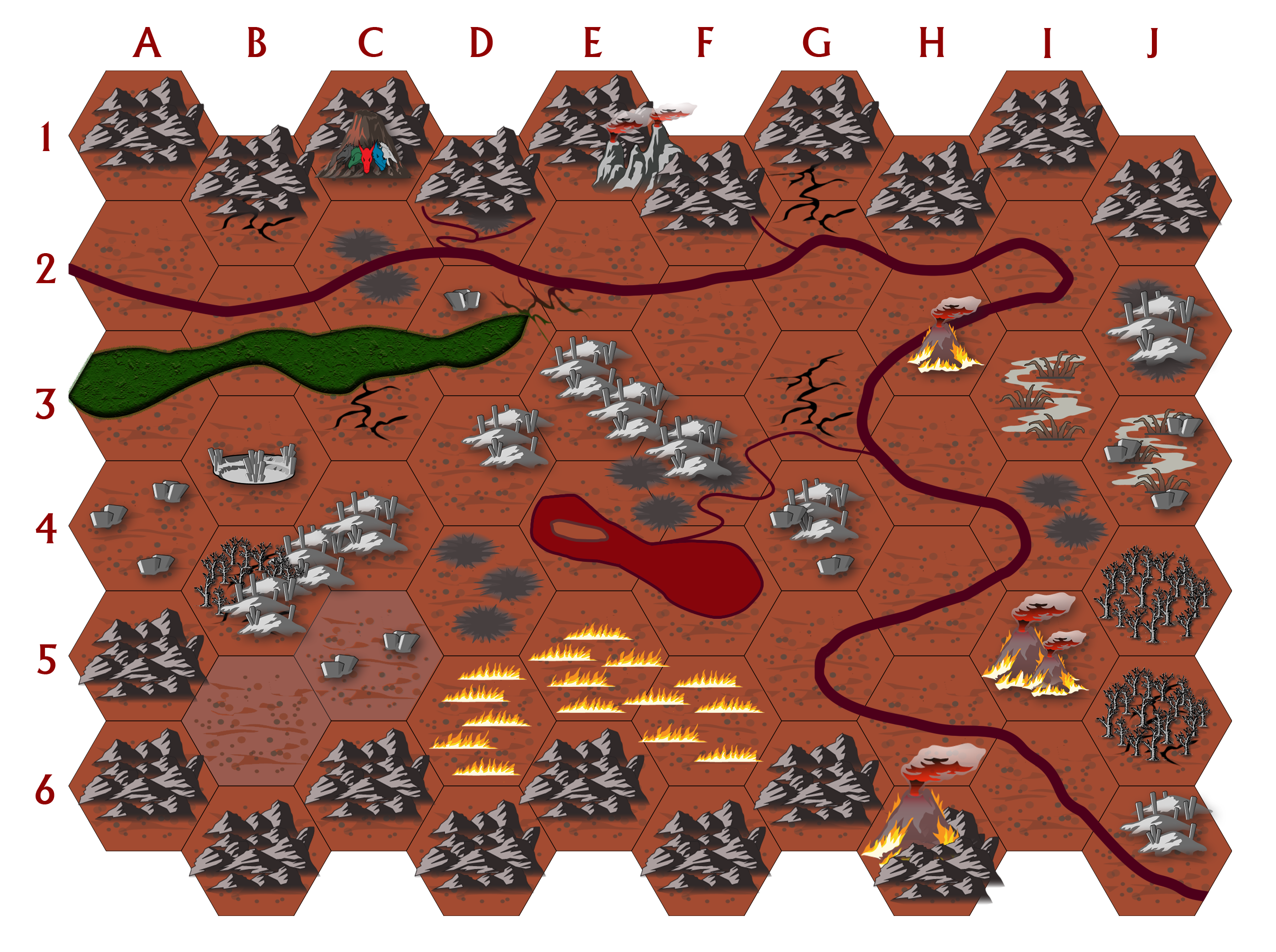











This is great stuff. It’s stuff like this that makes me want to play new campaigns.,
I believe there is an error in the first chart. Psychic Evil should be 7-9.
Also, to clarify, does an oppressive condition check succeed on a 2-6 on the d6 roll?
Wow, this is really superb. This hexcrawl series has really inspired me to try running one.
By the way, you do note how there are no highways on the Avernian map. However, that implies that there are roads. They don’t appear to be marked on the map, so if there are any, where are they?
What about those blasted hexes, like D4?
@dnob_nalon, if you look carefully at the players’ map, there is a road (the Coward’s Way) from G2 into G3, and possibly as far as I3. It also looks like there might be a road from D4 into I5 and possibly from A2 into A3 and through to C3. If you want, these roads could connect through D3, but it is also possible the section there is destroyed.
There really should be a highway, just to have an excuse for some AC/DC.
https://www.youtube.com/watch?v=l482T0yNkeo
@colin r
Thanks that helps. Would definitely be helpful to have on the DM map IMO. But I can understand if they weren’t noticed by Justin when he was making the DM map.
I’ll actually be taking a comprehensive look at roads after the key is done, quite possibly updating the map at that time.
The Coward’s Way, for example, is an interesting crux: It runs from Haruman’s Hill, but it’s not clear it’s actually a road. It looks quite large on the map, but that may just be illustrative of the location. And it doesn’t seem to go anywhere. But, it might. And it might also be metal to have a road of crucified people that runs for a full hex or more.
Regardless of fully mapped roads, that movement column will apply to local trails.
@Justin, I definitely think it’s fine to have roads in Avernus that don’t lead anywhere. Even leaving aside the “it’s Hell” argument, Avernus is ancient. Maybe they used to lead somewhere. It’s a war zone — maybe they lead to the front, or to where the front used to be, or to ruins. Maybe Bel liked to build roads and Zariel doesn’t bother. Maybe the roads *do* lead somewhere, but the lunatic Cartographer didn’t care about devil barracks and didn’t mark those down. (Avernus *is* supposed to be populated, but apart from Bel’s Forge and those towers in the northern mountains, the map shows almost no sign of it.)
FWIW I am certainly going full metal with the Coward’s Way.
Also, the Roman Empire round about the Third Century Crisis is a great role model for a lawful evil empire, and they were famous for roads. Give the Blood Legions something proper to march on. (And the PCs a way to get in trouble! Don’t get caught on a military road without papers.)
Did I mention Hell should also have lots of papers, and inspectors who will demand to see them? “Fortunately” for the players, though, this part of Avernus is close enough to the front line (and close enough to civil war) that the enforcement apparatus is too patchy to really get in their way.
Fort Knucklebone needs a forger, of course. Actual devils are compelled to respect proper authority, but Maggie and her gang just care about not getting caught, or at least remaining useful enough for the Legions to tolerate.
“Mortals make forage checks in Avernus at disadvantage.”
Didn’t you make a tweet about disliking this exact decision? Why’d you decide to go with it in the end?
Is Extreme Heat meant to be once per watch, rather than once per hour?
If it’s one check per hour that’s four checks per watch, and if the condition continues for 3-4 watches on average that’s going to be 12-16 constitution saving throws, on average. Once you’ve failed 3, you have disadvantage on all saving throws regardless of armour–some bad luck here could just flat out kill players, especially when many of the keyed locations in the adventure are outdoors and so won’t offer much in the way of shelter from the heat.
@Reveilled, note that the DC starts at 5, so the PCs are unlikely to fail too many checks off the top. Encouraging them to take off their armor, drink triple rations of water, and forge onward through the wasteland with turbans, loincloths and gleaming pecs, is metal.
But it could be improved by giving some thought to how the PCs might avoid the heat if necessary. Can they avoid saving throws by ceasing strenuous labor? Or any labor? By finding a cave to shelter in? By conjuring water or using a digging spell? There’s no sun in Avernus, so does shade exist? Does it help, or is the Extreme Heat all about air temperature? Or ground temperature?
Sheltering from the heat by building a platform to get off the ground might be fun.
Where are the Front Lines? I know skirmishes are happening all over the plain, but where is the major front for this multi-plane spanning war? I’m assuming closer to contra-Dis because according to the book Zariel pushed the demonic armies further away from the portal to Dis.
@colin: In terms of roads that end, sure. But the pertinent question is whether they go farther than 40 miles. If they don’t (i.e., they don’t leave a single hex), then they aren’t communicating any information on the hex map.
Same principle behind why every mountain stream doesn’t show up on a hex map.
@Reveilled: For Extreme Heat I’m using the default mechanics for 5th Edition. You could swap to watches, but as Colin suggests you’d probably want to crank up the DCs. My gut says probably something like DC 10 + 2 per watch, but I’d probably want to take a closer look at the math.
@Avian Overlord: Short version? No, I did not tweet that.
Long version: What I tweeted was that using disadvantage to model how difficult it is to find food when the DC of a forage check is set entirely by how difficult it is to find food doesn’t make sense. What you see here is a different mechanic: Being mortal is a disadvantage.
@Nick: Canonically (according to Planes of Law) the border of Avernus was once the Styx, but Hell has been steadily pushing the front lines of the war back from the river. Descent Into Avernus is more or less incoherent on this point: It frequently seems to assume that the Styx is the front lines of the war (demons, etc.), but half the locations are on on the far side of the river.
On this map, the front lines are assumed to be Abyss-ward off the edge of the map. It would be interesting to have had the campaign take place near the front lines, but:
(a) Probably not at the level range the campaign is designed for.
(b) That’s not the map we were given to work with.
Re: Extreme Heat
I just quickly did the math. Assuming a +0 roll modifier, to have the same chance of somebody not being exhausted after 4 rolls and 8 rolls at DC 5 + 1/hour as after 1 resp. 2 per-watch rolls, the per-watch roll needs to be DC 16 + 3/watch. It gives you a 20% chance not to be Exhausted after 1 watch, and a 1% chance after 2.
Oppressive heat is quite literally roll until you fail, and the fall-off is even faster than exponential thanks to the rising DC.
@Alien: the “roll until you fail” part is why I think the characters need to have some interesting options for managing it. Let them have an active decision for how far to push and not just “I hope this lets up soon.” Make them figure out how to build shelter or acquire water, for instance. Or make them fight a fire drake while stripped to their skivvies and carrying some exhaustion. Something like that? For an oppressive condition to be worth the screen time, there needs to be some way to make a scene out of it.
@ Justin: What is Avernus exactly?
Is Avernus more like an alien world or more like the religious notion of Hell we have on Earth? Also, given that Avernus is the gateway to Hell, non-fiends like the warlords should be pretty common right? Where do they live, how does trade and commerce work if devils are just drafted into the war, and who shops at Mahadi’s Emporium?
Does Avernus have cities, because it seems a lot more barren compared to Dis and the other layers. Given that it’s the first stop for all who enter the Hells, it should have more activity especially close to the Bronze Citadel.
@Nick, the map provided with DiA is of an area away from the Bronze Citadel (unless you want to decide that one of the towers at the top edge of the map is in fact the Bronze Citadel, unlabelled).
D&D maintains a strategic ambiguity about precisely what Avernus is, and DiA doesn’t provide much to clarify. I personally am going with the ‘alien world’ interpretation, and I’m going to end up inventing a bunch of details to answer questions like “who shops at Fort Knucklebone.” My impression from how Justin has described the goal of this Remix, though, is that he wants to take DiA as it was given to us and make it playable, not to rewrite the gazetteer of Hell. (I’d say, “not to write a ton of new content”, but, man, that ship has sailed. 🙂
Since when is the Abyss adjacent to Avernus?
@Reveilled, it’s worth noting that in any given watch, the chance of extreme heat is 1 in 24 (or 1 in 18 in plains of fire). Plus, if you’re a tiefling, or the right kind of dragonborn, you can ignore it completely. And a protection from energy spell can delay the effects for one person for an hour. (If you’re feeling generous, let the PC’s get their hands on a ring of fire resistance.)
Anyway, it’s Hell. It’s supposed to be a hostile environment.
@colin r: So are you making it similar to an empire or a feudal state, with more towns, cities, and nobility the further away from the front lines you go? The main thing I was wondering about was how to make Avernus feel like an actual place, not just a wacky setting for a game, and so some parts of what they gave in the book seemed lacking to me.
Also, based on the different types of warlords I assume there are lots of non-devils in Avernus. It seems monotonous for the players to only face off against 1 type of enemy, also from a roleplaying perspective since all devils are lawful evil.
@Wyvern: Idk, I always assumed that the Styx flowed from the Abyss and that it and Avernus were linked through Hades but maybe not.
@Nick, Imperial Rome is going to be my go-to reference when I need detail for how the place works (my players are in the Grand Cemetery now, so I haven’t quite got there, but have started thinking about it). That is: vast bureaucratic estates, worked by slaves, and a strict hierarchy of patronage up through Zariel to Asmodeus. We already have the Blood Legions, and the warlords are clients, nominally obedient to the Archduchess but jealous of their independence and strict about the letter of their obligations.
In general that’s true about all relations between devils — all parties are exceedingly particular about obedience to the very letter of all agreements, whether it makes any sense or not. That also means they are *very very* careful about what agreements they commit to, which means in practice that underlings retain a lot more independence than you might expect. It also means they waste really a lot of time and energy arguing about the meaning of slippery words like “is” and “then.”
The region of the campaign is frontier, weakly controlled and under threat from demon hordes, so mostly the big estates are not here — just the important mines at Bel’s Forge and a scattering of settlements like Knucklebone.
I really love these, it has helped me a lot. Just wondering when the next parts will be released?
Is there a way to get the hex tiles as images or something so we can build our own hex maps?
I am unsure about how many miles per hour can a warmachine travel. Has anyone any suggestions for this?
Thank you in advance
This is going to be of great help; I am wondering, has anyone discovered the Hex scale if using this and the official map in Roll20?
Question on oppressive condition around Pit of Shummrath
”Characters must succeed on a DC 15 Wisdom saving throw or suffer 2d6 psychic damage.”
frequency of saving throw not specified. Every hour? every watch? (every round ?!?).
thank you!
@Francis (#30) Reread the “oppressive environment” rule at the top. Once per watch, until the active oppressive condition changes again.
Note that there’s only a 1 in 6 chance per watch for an oppressive condition to begin, and the hex’s oppressive condition only occurs on a 12 (on a d12) if an oppressive condition begins. 1-11 give other more generic Avernian oppressive conditions. The oppressive condition continues until another 1 in 6 roll ends it.
First, thank your for all your work, I’m using almost everything!
Second, I’m sorry if this is somewhere but I didn’t find it. How does the players cross the river styx? This actually came up in my campaing and I didn’t belive I haven’t thought about it. I actually gave my players a couple of places (they asked Natasha in fort knucklebones) where it may be some sort of bridge (dock of fallen cities, stygian dock) and also told them Warlords sometimes build improvised ramps to cross, and if they’re lucky they may find one going along the shores of the styx.
@Adrian, I am probably late as you likely have sorted this out in your campaign, but there are a few locations on the hex map that allow crossing (Stygian Ramps, Ferryman’s ports, Zariel’s Bridge, etc.) but very much like you, my players also asked Natasha about crossing the Styx.
She told them that before Infernal War Machine technology was refined and adopted into the Infernal Legions, they were very much experimental death machines cobbled together by warlords, evil artificers, etc (one randomly had an idea to dump the ichor of Demons into it and what do you know? It worked! Gotta love Hell science lol).
So, during the times where they were simply mad max dune buggies with volatile malfunctions, there was really no need for the devils to dedicate resources to building infrastructure around them i.e. methods of crossing the Styx with them (there were already Merrenoloth ferrymen all over, but those ports were solely operated by skiffs made for a handful of creatures to cross at a time, definitely not hulking metal war machines). but that didn’t stop Warlords from Warlording, several of which made these make-shift ramps to cross the gaps which can still be found scattered across Avernus.
Eventually, when the machines were refined to a point where Zariel felt comfortable requisitioning the technology for her legions (what is more Zariel than war machines powered by damned souls and slain demons, right?), she very quickly made it a priority to establish methods to get across the Styx, as she had pushed the front lines of the Blood War past the Styx toward the Abyss. That is when more of the ports/docks around Avernus began to include platforms that could support the weight of these machines, albeit for a price (I had the price be 1 soul coin to cross, but you can make it whatever you like, obviously).
I made it clear that there were several ways across and each of them had pros/cons to them. Including:
– Remnants of ramps built throughout Avernus’ history. The risk here is pretty obvious unless one doesn’t value their mind lol.
– Official military-sanctioned machine platforms that will get you across no problem. The downside here is the price, Soul Coins are not cheap, especially if you follow Justin’s guide to having a Soul Coin economy that actually makes sense and not whatever the DiA writers “established” as their value (they didn’t).
– Standard bridges such as Zariel’s in hex G5a. The downside here is kind of up to you, I plan on making it more of a social encounter where the players have to get past the Stygian Watchtower guards that includes a very unpleasant Amnizu. These watchtowers are made to prevent demons from entering Avernus (many of which have the ability to assume other forms, such as humanoids, which means that even the players will likely run into some trouble convincing the devils that they aren’t demons and are here… willingly? Right… sure thing, guy who is definitely *not* a Maurezhi in disguise.)
Not positive all this aligns exactly with everything Justin has spelled out lore-wise, but it is the canon I decided to piece together with the help of the book, Justin, and some creative liberties. Hope this helps!
Also curious about the blasted hexes C2, D4, & I4 – what is the terrain feature for those?
Also curious about blasted hexes C2, D4 and I4.
thanks!